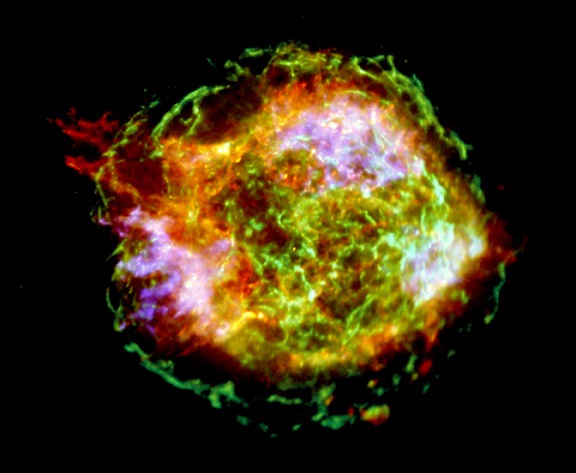Explanation: One million seconds of x-ray image data were used to construct this view of supernova remnant Cassiopeia A, the expanding debris cloud from a stellar explosion. The stunningly detailed image from the Chandra Observatory will allow an unprecedented exploration of the catastrophic fate that awaits stars much more massive than the Sun. Seen in false-color, Cas A's outer green ring, 10 light-years or so in diameter, marks the location of the expanding shock from the original supernova explosion. At about 10 o'clock around the ring, a structure extends beyond it, evidence that the initial explosion may have also produced energetic jets. Still glowing in x-rays, the tiny point source near the center of Cas A is a neutron star, the collapsed remains of the stellar core. While Cas A is about 10,000 light-years away, light from the supernova explosion first reached Earth just over 300 years ago.
1999 2000 2001 2002 2003 2004 2005 2006 2007 2008 2009 2010 2011 2012 2013 2014 2015 2016 2017 2018 2019 2020 2021 2022 2023 2024 2025 |
Yanvar' Fevral' Mart Aprel' Mai Iyun' Iyul' Avgust Sentyabr' Oktyabr' Noyabr' Dekabr' |
NASA Web Site Statements, Warnings, and Disclaimers
NASA Official: Jay Norris. Specific rights apply.
A service of: LHEA at NASA / GSFC
& Michigan Tech. U.
|
Publikacii s klyuchevymi slovami:
Cas A - supernova remnant - neutron star - ostatok Sverhnovoi - neitronnye zvezdy - rentgenovskoe izluchenie
Publikacii so slovami: Cas A - supernova remnant - neutron star - ostatok Sverhnovoi - neitronnye zvezdy - rentgenovskoe izluchenie | |
Sm. takzhe:
Vse publikacii na tu zhe temu >> | |
